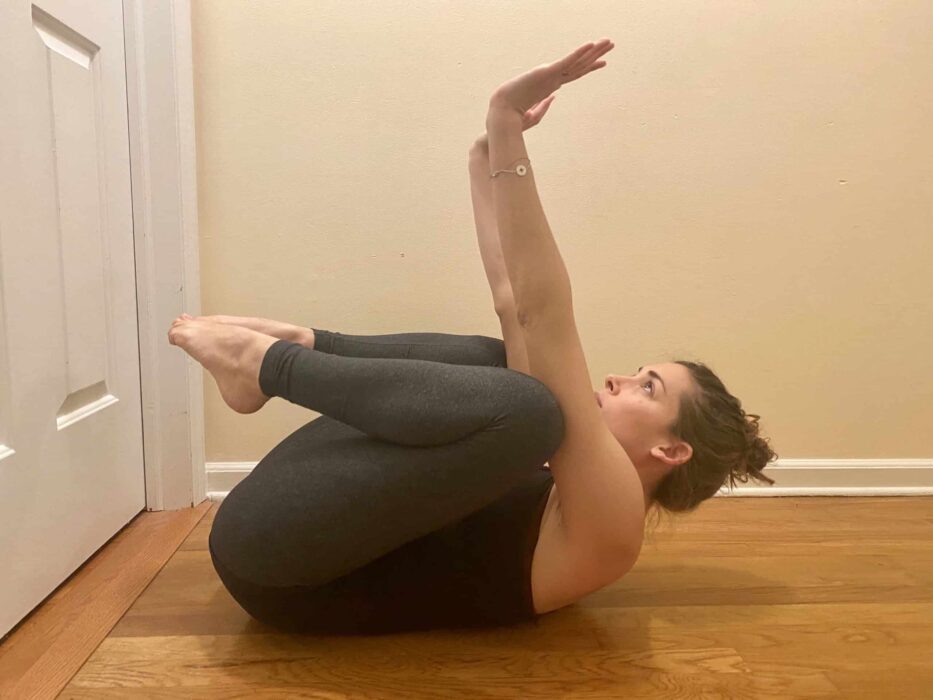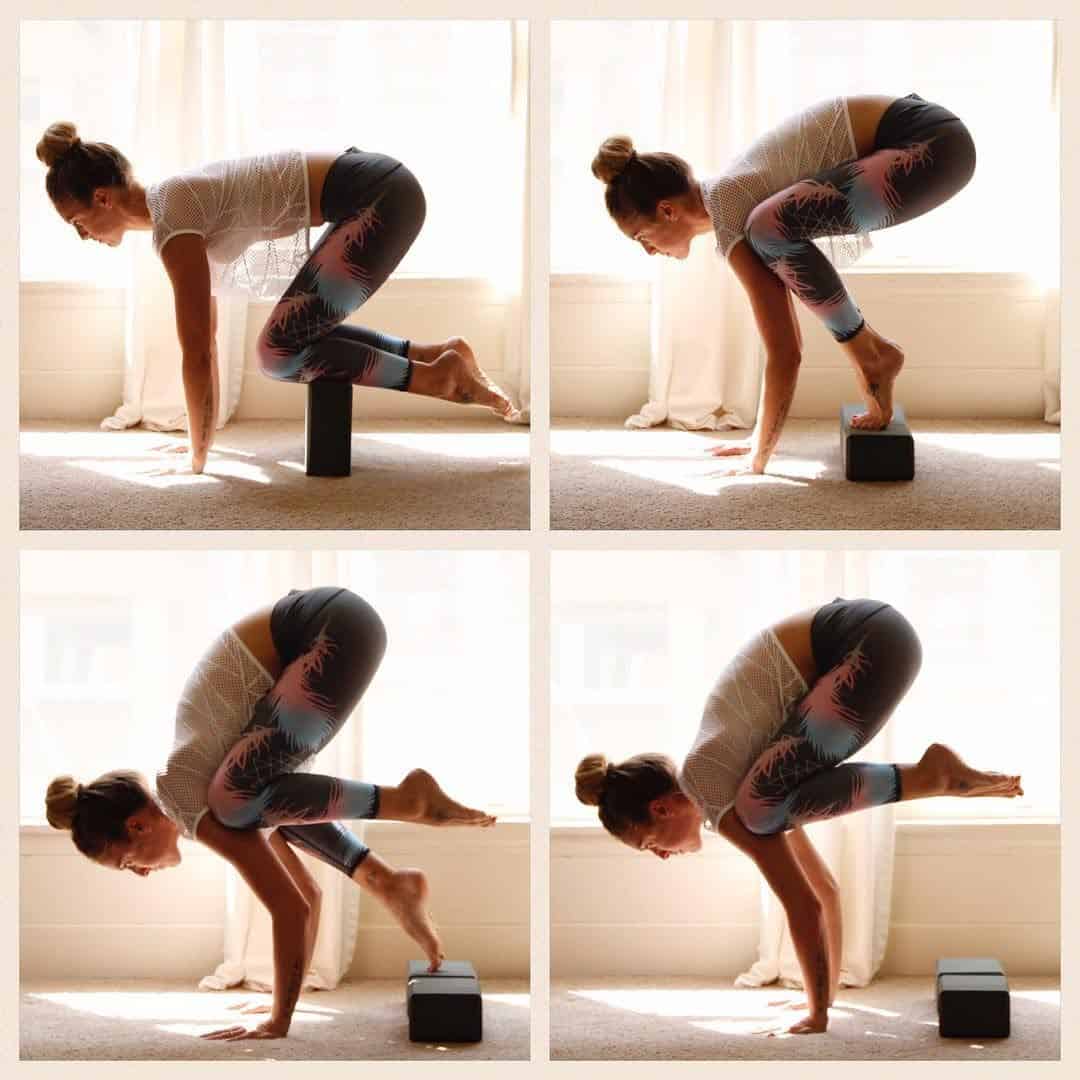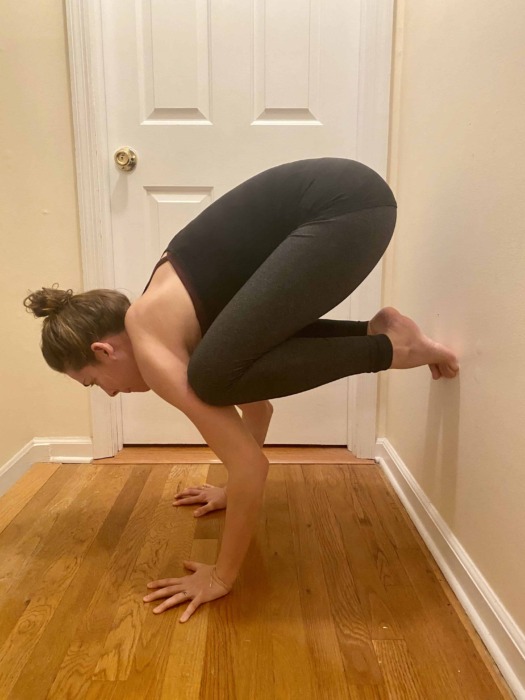The crow pose is the first arm balance you will practice in your yoga class. It requires arms and core strength as well as balancing skills. But most of all, it requires bravery to really try doing it for the first time. So for all brave ones, let’s see what options are there for Crow pose.
Crow Pose Variations
Lie Down

The load on shoulders and arms in the Crow pose can be challenging for beginners. So to make it easier and understand it more profound, use the lie-down option.
- Lie down on the mat.
- Bend your knees and hug your knees with your hands to pull them closer to the chest. Engage your core to hold legs next to the armpits.
- Reach your palms up, firmly flex your wrists as if they’re standing on the floor.
- Try to really feel what core and arm muscles work in this pose.
- Ensure your neck is neutral and not squeezed between your shoulders.
Supported Shoulderstand (Salamba Sarvangasana)
Crow Pose with Something to Lean On

Blocks come in handy when you master the Crow pose. Here’re some options on how to use them:
- Grab a block and put it in front of you.
- Sit down into a yoga squat with your toes together and knees wide apart.
- Put your palms on the floor right under your shoulders and behind the block. Ensure your palms are spread wide and have a proper grip on the mat. Press your fingertips to the floor.
- Spread your knees wide to the sides. Make your knees touch the middle of the shoulder bones and try to “hug” your shoulder with your legs.
- Bend your elbows as in the Chaturanga pose and hold them wide apart.
- Start to shift your weight forward until your forehead touches the block.
- Lift your pelvis up and balance on your toes. When you are ready, start to lift toes one by one and enter the Crow pose.
- Hold for as long as you can.
Lift the Floor

Using a block as a perch can be very useful if you try to feel the necessary lift in the hips area.
Here’s how it works:
- Place a block next to your legs. Step on it and raise the balls of your feet. Keep the toes touching each other and spread knees and hips wide apart.
- Place your palms on the floor and bend your elbows to create Chaturanga-shaped elbows.
- Start to lean forward by shifting your weight and balancing.
- Lift one foot at a time off the block. Do that with other foot too.
Using the Wall

Wall is another excellent yoga prop. Plus, this is something that is always at hand. So here’s how to do Crow pose next to the wall:
- Put your mat parallel to the wall. You can also use block in the position from previous options.
- Start in a yoga squat so that the wall is behind you. Place your palms on the floor and bend your elbows.
- Put your knee wide apart and hug your shoulder bones with your thighs.
- Start slowly walking your feet up the wall.
- Hold as long as you can, and then release.
4 Plank Pose Variations for Full-body Training
One-legged Crow Pose
This option is more for advanced practitioners. To enter it, follow all the usual steps for Crow pose but leave one leg up and behind you.
Like this:
How Long It Takes to Master Crow Pose?
If you practice regularly, it may take days and weeks to master the Crow pose. Therefore, you may need to include some Crow pose drills in your practice.
Crow Pose Drills
Squat to open your hips. Put your feet mat width apart or wider. Make sure your toes are pointed out to the sides. As you exhale, sit down, so your pelvis is between your feet. Hold your palms in the Anjali mudra next to your chest and your elbows pressed to the inner side of your thighs. Hold for 30-60 seconds and more.
Plank pose in motion. Find the downward-facing dog pose. From there, lift the right leg and move to the plank pose with a lifted leg. Next, bend the right leg and touch the elbow as you exhale. Inhale and move back to the downward-facing dog. Repeat with the left leg. Do as many repetitions as you can.
Can Anyone Do Crow Pose?
Yes, anyone can practice Crow pose. But this yoga pose is not recommended for people with wrists and shoulder joint issues. If you have a recent trauma or surgery, then you should avoid practicing this pose.